Business Information Modelling: A Gulf Construction Revolution
VerifiedAdded on 2023/06/12
|74
|15404
|280
Report
AI Summary
This report provides an overview of Business Information Modelling (BIM) and its revolutionary impact on the construction industry in the Gulf region. It begins by introducing the background of the construction industry in the Gulf Region and explaining the concept of BIM. The report outlines the objectives and research questions, followed by a literature review that examines the concept of BIM, reasons for its adoption, its use in sustainable construction practices and the built environment, and the challenges faced in Gulf nations. The research methodology includes discussions on research philosophy, approach, logic, design, sampling method, data gathering, and analysis techniques. The data analysis and discussion chapter presents frequency, descriptive, correlation, and thematic analyses of collected data, focusing on the impact of BIM on project success, time and cost, and improved collaboration. The report concludes by summarizing the findings, addressing the research objectives, providing recommendations, and suggesting areas for future work, highlighting the potential for further development and integration of BIM in the construction industry.
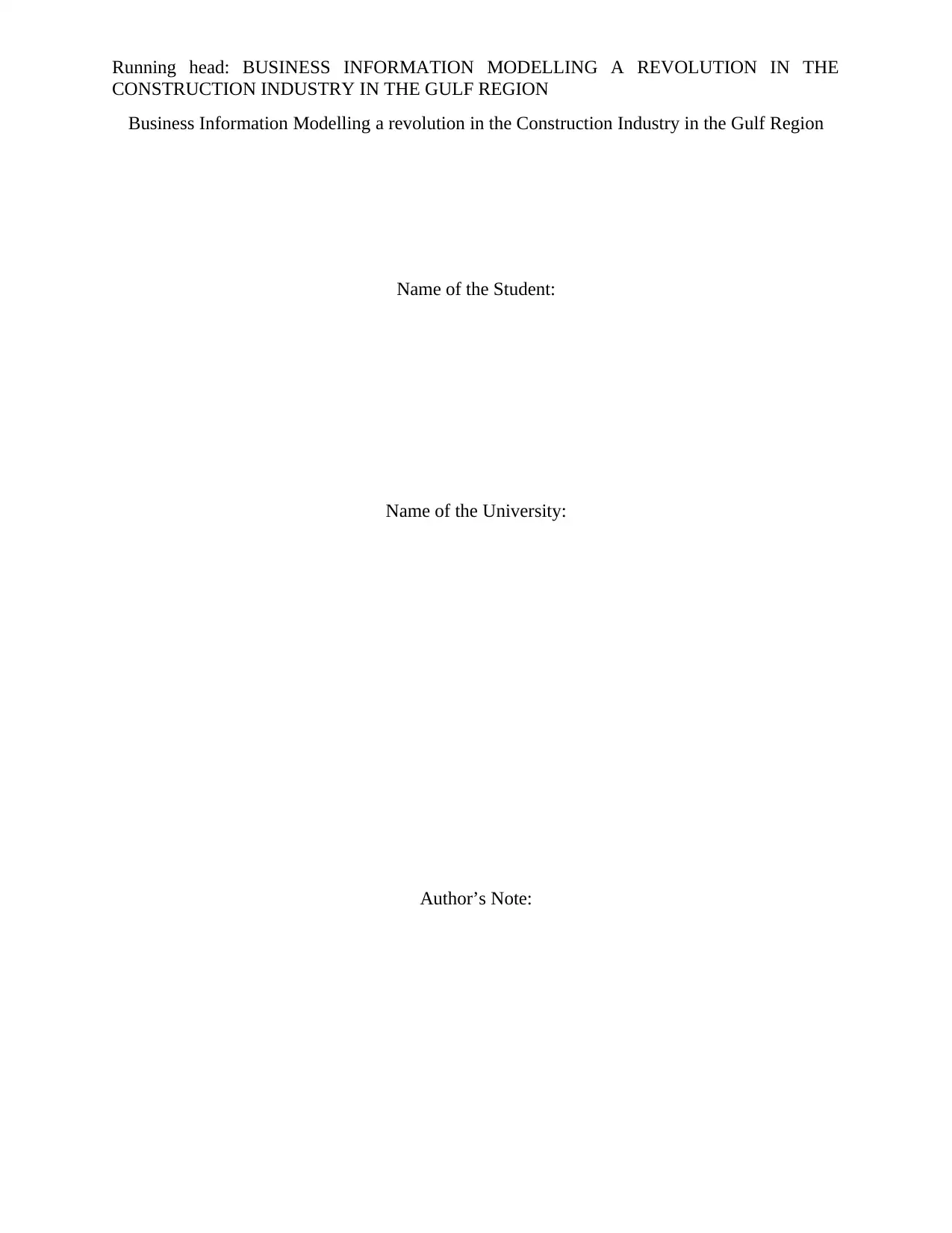
Running head: BUSINESS INFORMATION MODELLING A REVOLUTION IN THE
CONSTRUCTION INDUSTRY IN THE GULF REGION
Business Information Modelling a revolution in the Construction Industry in the Gulf Region
Name of the Student:
Name of the University:
Author’s Note:
CONSTRUCTION INDUSTRY IN THE GULF REGION
Business Information Modelling a revolution in the Construction Industry in the Gulf Region
Name of the Student:
Name of the University:
Author’s Note:
Paraphrase This Document
Need a fresh take? Get an instant paraphrase of this document with our AI Paraphraser
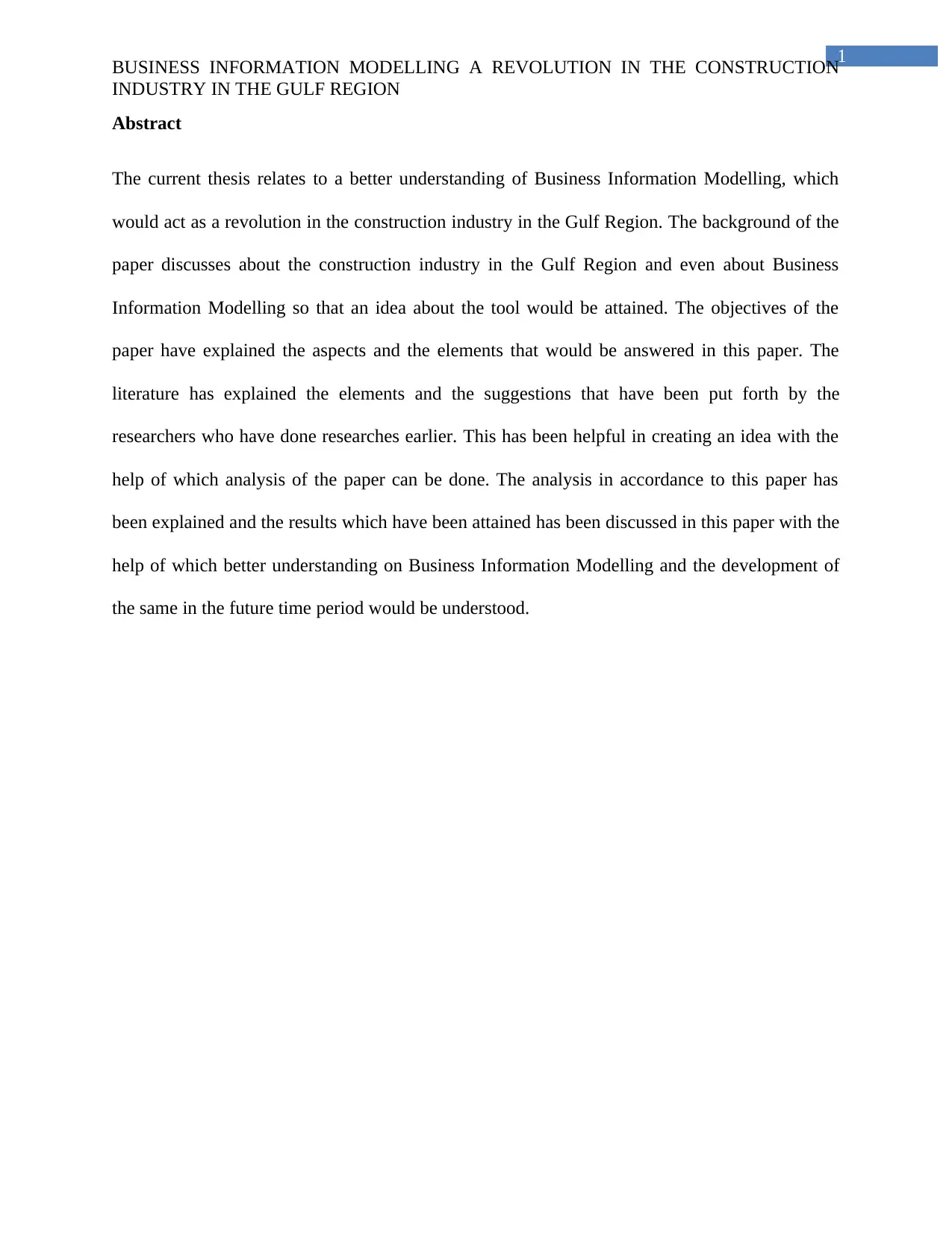
1
BUSINESS INFORMATION MODELLING A REVOLUTION IN THE CONSTRUCTION
INDUSTRY IN THE GULF REGION
Abstract
The current thesis relates to a better understanding of Business Information Modelling, which
would act as a revolution in the construction industry in the Gulf Region. The background of the
paper discusses about the construction industry in the Gulf Region and even about Business
Information Modelling so that an idea about the tool would be attained. The objectives of the
paper have explained the aspects and the elements that would be answered in this paper. The
literature has explained the elements and the suggestions that have been put forth by the
researchers who have done researches earlier. This has been helpful in creating an idea with the
help of which analysis of the paper can be done. The analysis in accordance to this paper has
been explained and the results which have been attained has been discussed in this paper with the
help of which better understanding on Business Information Modelling and the development of
the same in the future time period would be understood.
BUSINESS INFORMATION MODELLING A REVOLUTION IN THE CONSTRUCTION
INDUSTRY IN THE GULF REGION
Abstract
The current thesis relates to a better understanding of Business Information Modelling, which
would act as a revolution in the construction industry in the Gulf Region. The background of the
paper discusses about the construction industry in the Gulf Region and even about Business
Information Modelling so that an idea about the tool would be attained. The objectives of the
paper have explained the aspects and the elements that would be answered in this paper. The
literature has explained the elements and the suggestions that have been put forth by the
researchers who have done researches earlier. This has been helpful in creating an idea with the
help of which analysis of the paper can be done. The analysis in accordance to this paper has
been explained and the results which have been attained has been discussed in this paper with the
help of which better understanding on Business Information Modelling and the development of
the same in the future time period would be understood.
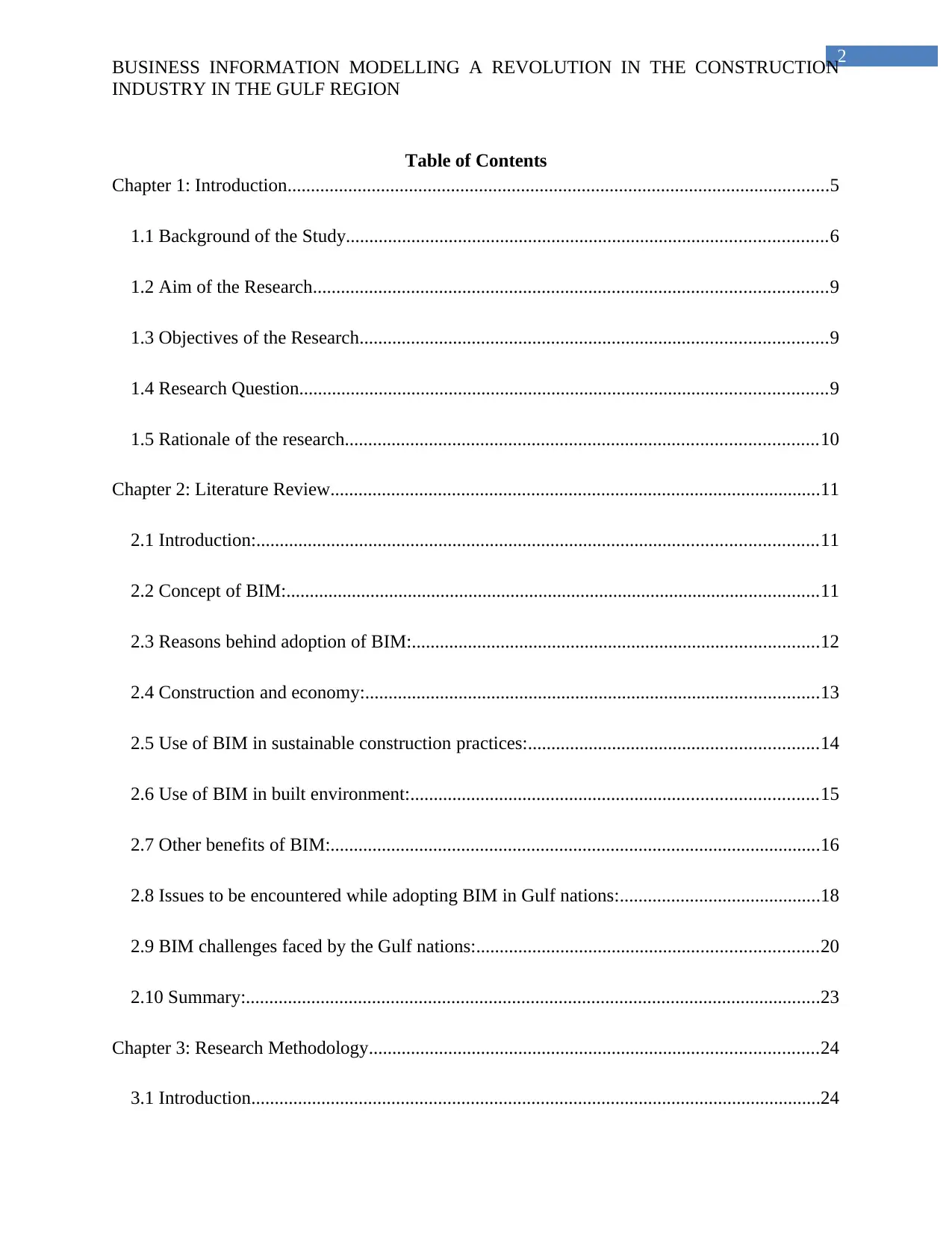
2
BUSINESS INFORMATION MODELLING A REVOLUTION IN THE CONSTRUCTION
INDUSTRY IN THE GULF REGION
Table of Contents
Chapter 1: Introduction....................................................................................................................5
1.1 Background of the Study.......................................................................................................6
1.2 Aim of the Research..............................................................................................................9
1.3 Objectives of the Research....................................................................................................9
1.4 Research Question.................................................................................................................9
1.5 Rationale of the research.....................................................................................................10
Chapter 2: Literature Review.........................................................................................................11
2.1 Introduction:........................................................................................................................11
2.2 Concept of BIM:..................................................................................................................11
2.3 Reasons behind adoption of BIM:.......................................................................................12
2.4 Construction and economy:.................................................................................................13
2.5 Use of BIM in sustainable construction practices:..............................................................14
2.6 Use of BIM in built environment:.......................................................................................15
2.7 Other benefits of BIM:.........................................................................................................16
2.8 Issues to be encountered while adopting BIM in Gulf nations:...........................................18
2.9 BIM challenges faced by the Gulf nations:.........................................................................20
2.10 Summary:...........................................................................................................................23
Chapter 3: Research Methodology................................................................................................24
3.1 Introduction..........................................................................................................................24
BUSINESS INFORMATION MODELLING A REVOLUTION IN THE CONSTRUCTION
INDUSTRY IN THE GULF REGION
Table of Contents
Chapter 1: Introduction....................................................................................................................5
1.1 Background of the Study.......................................................................................................6
1.2 Aim of the Research..............................................................................................................9
1.3 Objectives of the Research....................................................................................................9
1.4 Research Question.................................................................................................................9
1.5 Rationale of the research.....................................................................................................10
Chapter 2: Literature Review.........................................................................................................11
2.1 Introduction:........................................................................................................................11
2.2 Concept of BIM:..................................................................................................................11
2.3 Reasons behind adoption of BIM:.......................................................................................12
2.4 Construction and economy:.................................................................................................13
2.5 Use of BIM in sustainable construction practices:..............................................................14
2.6 Use of BIM in built environment:.......................................................................................15
2.7 Other benefits of BIM:.........................................................................................................16
2.8 Issues to be encountered while adopting BIM in Gulf nations:...........................................18
2.9 BIM challenges faced by the Gulf nations:.........................................................................20
2.10 Summary:...........................................................................................................................23
Chapter 3: Research Methodology................................................................................................24
3.1 Introduction..........................................................................................................................24
⊘ This is a preview!⊘
Do you want full access?
Subscribe today to unlock all pages.

Trusted by 1+ million students worldwide
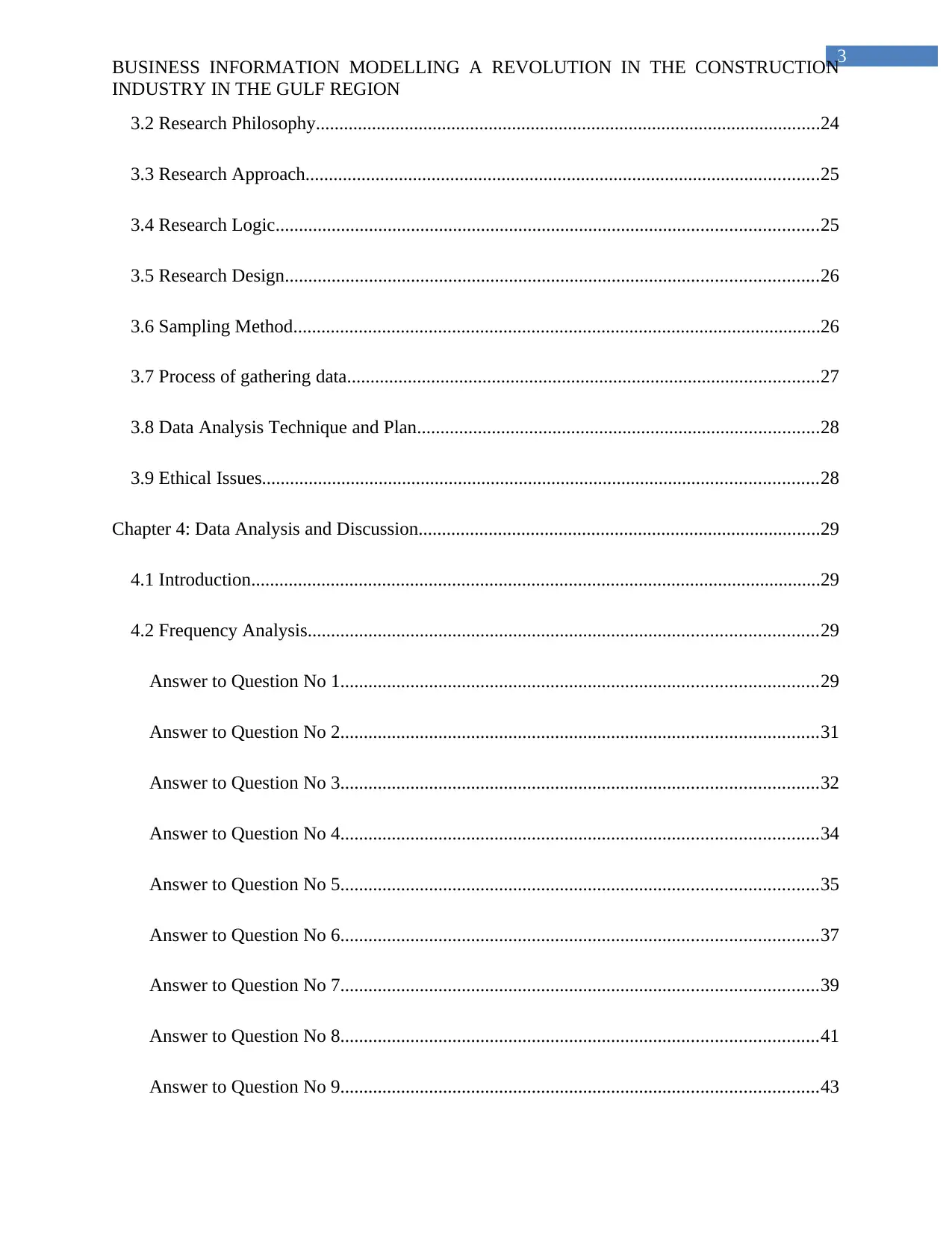
3
BUSINESS INFORMATION MODELLING A REVOLUTION IN THE CONSTRUCTION
INDUSTRY IN THE GULF REGION
3.2 Research Philosophy............................................................................................................24
3.3 Research Approach..............................................................................................................25
3.4 Research Logic....................................................................................................................25
3.5 Research Design..................................................................................................................26
3.6 Sampling Method.................................................................................................................26
3.7 Process of gathering data.....................................................................................................27
3.8 Data Analysis Technique and Plan......................................................................................28
3.9 Ethical Issues.......................................................................................................................28
Chapter 4: Data Analysis and Discussion......................................................................................29
4.1 Introduction..........................................................................................................................29
4.2 Frequency Analysis.............................................................................................................29
Answer to Question No 1......................................................................................................29
Answer to Question No 2......................................................................................................31
Answer to Question No 3......................................................................................................32
Answer to Question No 4......................................................................................................34
Answer to Question No 5......................................................................................................35
Answer to Question No 6......................................................................................................37
Answer to Question No 7......................................................................................................39
Answer to Question No 8......................................................................................................41
Answer to Question No 9......................................................................................................43
BUSINESS INFORMATION MODELLING A REVOLUTION IN THE CONSTRUCTION
INDUSTRY IN THE GULF REGION
3.2 Research Philosophy............................................................................................................24
3.3 Research Approach..............................................................................................................25
3.4 Research Logic....................................................................................................................25
3.5 Research Design..................................................................................................................26
3.6 Sampling Method.................................................................................................................26
3.7 Process of gathering data.....................................................................................................27
3.8 Data Analysis Technique and Plan......................................................................................28
3.9 Ethical Issues.......................................................................................................................28
Chapter 4: Data Analysis and Discussion......................................................................................29
4.1 Introduction..........................................................................................................................29
4.2 Frequency Analysis.............................................................................................................29
Answer to Question No 1......................................................................................................29
Answer to Question No 2......................................................................................................31
Answer to Question No 3......................................................................................................32
Answer to Question No 4......................................................................................................34
Answer to Question No 5......................................................................................................35
Answer to Question No 6......................................................................................................37
Answer to Question No 7......................................................................................................39
Answer to Question No 8......................................................................................................41
Answer to Question No 9......................................................................................................43
Paraphrase This Document
Need a fresh take? Get an instant paraphrase of this document with our AI Paraphraser
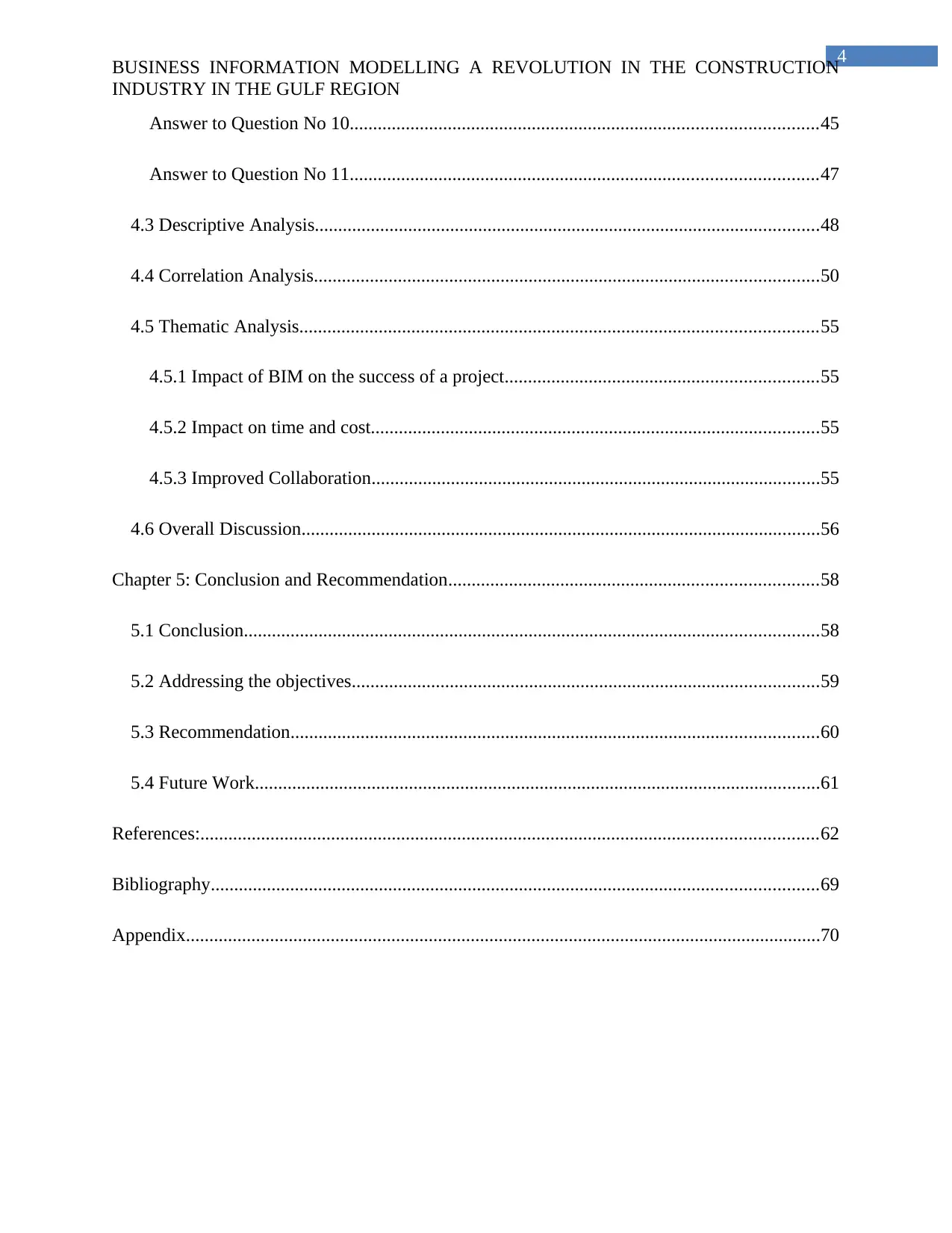
4
BUSINESS INFORMATION MODELLING A REVOLUTION IN THE CONSTRUCTION
INDUSTRY IN THE GULF REGION
Answer to Question No 10....................................................................................................45
Answer to Question No 11....................................................................................................47
4.3 Descriptive Analysis............................................................................................................48
4.4 Correlation Analysis............................................................................................................50
4.5 Thematic Analysis...............................................................................................................55
4.5.1 Impact of BIM on the success of a project...................................................................55
4.5.2 Impact on time and cost................................................................................................55
4.5.3 Improved Collaboration................................................................................................55
4.6 Overall Discussion...............................................................................................................56
Chapter 5: Conclusion and Recommendation...............................................................................58
5.1 Conclusion...........................................................................................................................58
5.2 Addressing the objectives....................................................................................................59
5.3 Recommendation.................................................................................................................60
5.4 Future Work.........................................................................................................................61
References:....................................................................................................................................62
Bibliography..................................................................................................................................69
Appendix........................................................................................................................................70
BUSINESS INFORMATION MODELLING A REVOLUTION IN THE CONSTRUCTION
INDUSTRY IN THE GULF REGION
Answer to Question No 10....................................................................................................45
Answer to Question No 11....................................................................................................47
4.3 Descriptive Analysis............................................................................................................48
4.4 Correlation Analysis............................................................................................................50
4.5 Thematic Analysis...............................................................................................................55
4.5.1 Impact of BIM on the success of a project...................................................................55
4.5.2 Impact on time and cost................................................................................................55
4.5.3 Improved Collaboration................................................................................................55
4.6 Overall Discussion...............................................................................................................56
Chapter 5: Conclusion and Recommendation...............................................................................58
5.1 Conclusion...........................................................................................................................58
5.2 Addressing the objectives....................................................................................................59
5.3 Recommendation.................................................................................................................60
5.4 Future Work.........................................................................................................................61
References:....................................................................................................................................62
Bibliography..................................................................................................................................69
Appendix........................................................................................................................................70
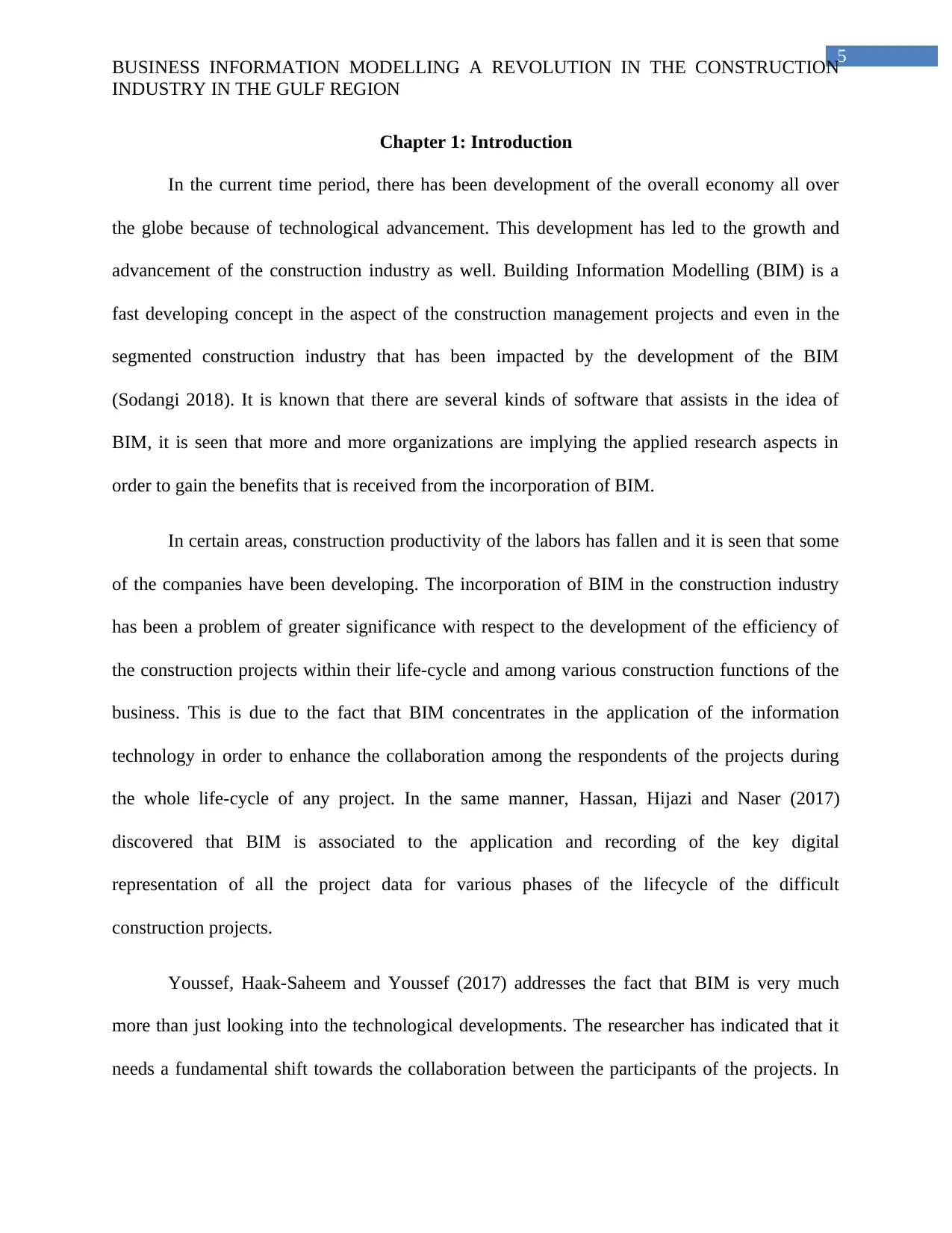
5
BUSINESS INFORMATION MODELLING A REVOLUTION IN THE CONSTRUCTION
INDUSTRY IN THE GULF REGION
Chapter 1: Introduction
In the current time period, there has been development of the overall economy all over
the globe because of technological advancement. This development has led to the growth and
advancement of the construction industry as well. Building Information Modelling (BIM) is a
fast developing concept in the aspect of the construction management projects and even in the
segmented construction industry that has been impacted by the development of the BIM
(Sodangi 2018). It is known that there are several kinds of software that assists in the idea of
BIM, it is seen that more and more organizations are implying the applied research aspects in
order to gain the benefits that is received from the incorporation of BIM.
In certain areas, construction productivity of the labors has fallen and it is seen that some
of the companies have been developing. The incorporation of BIM in the construction industry
has been a problem of greater significance with respect to the development of the efficiency of
the construction projects within their life-cycle and among various construction functions of the
business. This is due to the fact that BIM concentrates in the application of the information
technology in order to enhance the collaboration among the respondents of the projects during
the whole life-cycle of any project. In the same manner, Hassan, Hijazi and Naser (2017)
discovered that BIM is associated to the application and recording of the key digital
representation of all the project data for various phases of the lifecycle of the difficult
construction projects.
Youssef, Haak-Saheem and Youssef (2017) addresses the fact that BIM is very much
more than just looking into the technological developments. The researcher has indicated that it
needs a fundamental shift towards the collaboration between the participants of the projects. In
BUSINESS INFORMATION MODELLING A REVOLUTION IN THE CONSTRUCTION
INDUSTRY IN THE GULF REGION
Chapter 1: Introduction
In the current time period, there has been development of the overall economy all over
the globe because of technological advancement. This development has led to the growth and
advancement of the construction industry as well. Building Information Modelling (BIM) is a
fast developing concept in the aspect of the construction management projects and even in the
segmented construction industry that has been impacted by the development of the BIM
(Sodangi 2018). It is known that there are several kinds of software that assists in the idea of
BIM, it is seen that more and more organizations are implying the applied research aspects in
order to gain the benefits that is received from the incorporation of BIM.
In certain areas, construction productivity of the labors has fallen and it is seen that some
of the companies have been developing. The incorporation of BIM in the construction industry
has been a problem of greater significance with respect to the development of the efficiency of
the construction projects within their life-cycle and among various construction functions of the
business. This is due to the fact that BIM concentrates in the application of the information
technology in order to enhance the collaboration among the respondents of the projects during
the whole life-cycle of any project. In the same manner, Hassan, Hijazi and Naser (2017)
discovered that BIM is associated to the application and recording of the key digital
representation of all the project data for various phases of the lifecycle of the difficult
construction projects.
Youssef, Haak-Saheem and Youssef (2017) addresses the fact that BIM is very much
more than just looking into the technological developments. The researcher has indicated that it
needs a fundamental shift towards the collaboration between the participants of the projects. In
⊘ This is a preview!⊘
Do you want full access?
Subscribe today to unlock all pages.

Trusted by 1+ million students worldwide
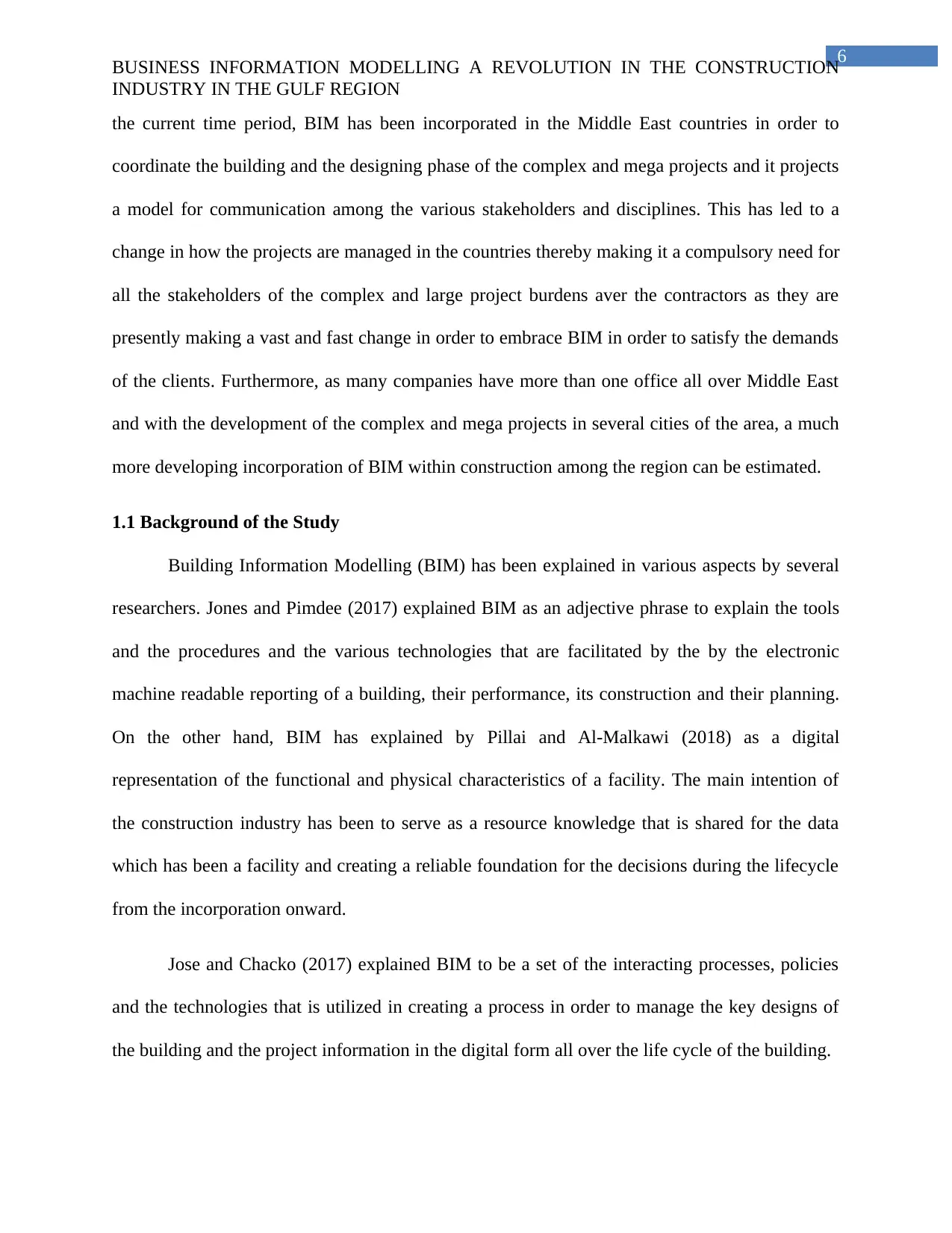
6
BUSINESS INFORMATION MODELLING A REVOLUTION IN THE CONSTRUCTION
INDUSTRY IN THE GULF REGION
the current time period, BIM has been incorporated in the Middle East countries in order to
coordinate the building and the designing phase of the complex and mega projects and it projects
a model for communication among the various stakeholders and disciplines. This has led to a
change in how the projects are managed in the countries thereby making it a compulsory need for
all the stakeholders of the complex and large project burdens aver the contractors as they are
presently making a vast and fast change in order to embrace BIM in order to satisfy the demands
of the clients. Furthermore, as many companies have more than one office all over Middle East
and with the development of the complex and mega projects in several cities of the area, a much
more developing incorporation of BIM within construction among the region can be estimated.
1.1 Background of the Study
Building Information Modelling (BIM) has been explained in various aspects by several
researchers. Jones and Pimdee (2017) explained BIM as an adjective phrase to explain the tools
and the procedures and the various technologies that are facilitated by the by the electronic
machine readable reporting of a building, their performance, its construction and their planning.
On the other hand, BIM has explained by Pillai and Al-Malkawi (2018) as a digital
representation of the functional and physical characteristics of a facility. The main intention of
the construction industry has been to serve as a resource knowledge that is shared for the data
which has been a facility and creating a reliable foundation for the decisions during the lifecycle
from the incorporation onward.
Jose and Chacko (2017) explained BIM to be a set of the interacting processes, policies
and the technologies that is utilized in creating a process in order to manage the key designs of
the building and the project information in the digital form all over the life cycle of the building.
BUSINESS INFORMATION MODELLING A REVOLUTION IN THE CONSTRUCTION
INDUSTRY IN THE GULF REGION
the current time period, BIM has been incorporated in the Middle East countries in order to
coordinate the building and the designing phase of the complex and mega projects and it projects
a model for communication among the various stakeholders and disciplines. This has led to a
change in how the projects are managed in the countries thereby making it a compulsory need for
all the stakeholders of the complex and large project burdens aver the contractors as they are
presently making a vast and fast change in order to embrace BIM in order to satisfy the demands
of the clients. Furthermore, as many companies have more than one office all over Middle East
and with the development of the complex and mega projects in several cities of the area, a much
more developing incorporation of BIM within construction among the region can be estimated.
1.1 Background of the Study
Building Information Modelling (BIM) has been explained in various aspects by several
researchers. Jones and Pimdee (2017) explained BIM as an adjective phrase to explain the tools
and the procedures and the various technologies that are facilitated by the by the electronic
machine readable reporting of a building, their performance, its construction and their planning.
On the other hand, BIM has explained by Pillai and Al-Malkawi (2018) as a digital
representation of the functional and physical characteristics of a facility. The main intention of
the construction industry has been to serve as a resource knowledge that is shared for the data
which has been a facility and creating a reliable foundation for the decisions during the lifecycle
from the incorporation onward.
Jose and Chacko (2017) explained BIM to be a set of the interacting processes, policies
and the technologies that is utilized in creating a process in order to manage the key designs of
the building and the project information in the digital form all over the life cycle of the building.
Paraphrase This Document
Need a fresh take? Get an instant paraphrase of this document with our AI Paraphraser
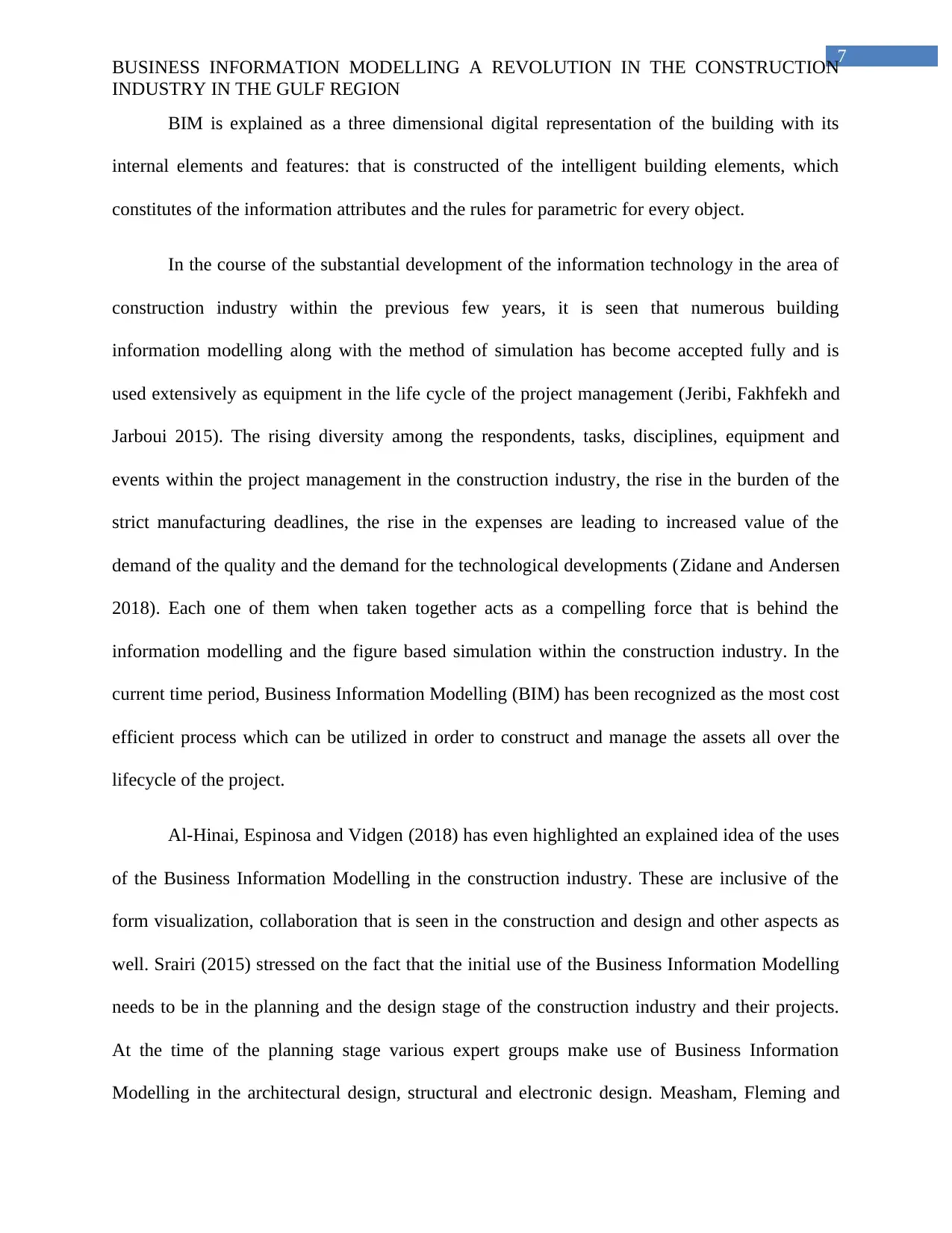
7
BUSINESS INFORMATION MODELLING A REVOLUTION IN THE CONSTRUCTION
INDUSTRY IN THE GULF REGION
BIM is explained as a three dimensional digital representation of the building with its
internal elements and features: that is constructed of the intelligent building elements, which
constitutes of the information attributes and the rules for parametric for every object.
In the course of the substantial development of the information technology in the area of
construction industry within the previous few years, it is seen that numerous building
information modelling along with the method of simulation has become accepted fully and is
used extensively as equipment in the life cycle of the project management (Jeribi, Fakhfekh and
Jarboui 2015). The rising diversity among the respondents, tasks, disciplines, equipment and
events within the project management in the construction industry, the rise in the burden of the
strict manufacturing deadlines, the rise in the expenses are leading to increased value of the
demand of the quality and the demand for the technological developments (Zidane and Andersen
2018). Each one of them when taken together acts as a compelling force that is behind the
information modelling and the figure based simulation within the construction industry. In the
current time period, Business Information Modelling (BIM) has been recognized as the most cost
efficient process which can be utilized in order to construct and manage the assets all over the
lifecycle of the project.
Al-Hinai, Espinosa and Vidgen (2018) has even highlighted an explained idea of the uses
of the Business Information Modelling in the construction industry. These are inclusive of the
form visualization, collaboration that is seen in the construction and design and other aspects as
well. Srairi (2015) stressed on the fact that the initial use of the Business Information Modelling
needs to be in the planning and the design stage of the construction industry and their projects.
At the time of the planning stage various expert groups make use of Business Information
Modelling in the architectural design, structural and electronic design. Measham, Fleming and
BUSINESS INFORMATION MODELLING A REVOLUTION IN THE CONSTRUCTION
INDUSTRY IN THE GULF REGION
BIM is explained as a three dimensional digital representation of the building with its
internal elements and features: that is constructed of the intelligent building elements, which
constitutes of the information attributes and the rules for parametric for every object.
In the course of the substantial development of the information technology in the area of
construction industry within the previous few years, it is seen that numerous building
information modelling along with the method of simulation has become accepted fully and is
used extensively as equipment in the life cycle of the project management (Jeribi, Fakhfekh and
Jarboui 2015). The rising diversity among the respondents, tasks, disciplines, equipment and
events within the project management in the construction industry, the rise in the burden of the
strict manufacturing deadlines, the rise in the expenses are leading to increased value of the
demand of the quality and the demand for the technological developments (Zidane and Andersen
2018). Each one of them when taken together acts as a compelling force that is behind the
information modelling and the figure based simulation within the construction industry. In the
current time period, Business Information Modelling (BIM) has been recognized as the most cost
efficient process which can be utilized in order to construct and manage the assets all over the
lifecycle of the project.
Al-Hinai, Espinosa and Vidgen (2018) has even highlighted an explained idea of the uses
of the Business Information Modelling in the construction industry. These are inclusive of the
form visualization, collaboration that is seen in the construction and design and other aspects as
well. Srairi (2015) stressed on the fact that the initial use of the Business Information Modelling
needs to be in the planning and the design stage of the construction industry and their projects.
At the time of the planning stage various expert groups make use of Business Information
Modelling in the architectural design, structural and electronic design. Measham, Fleming and
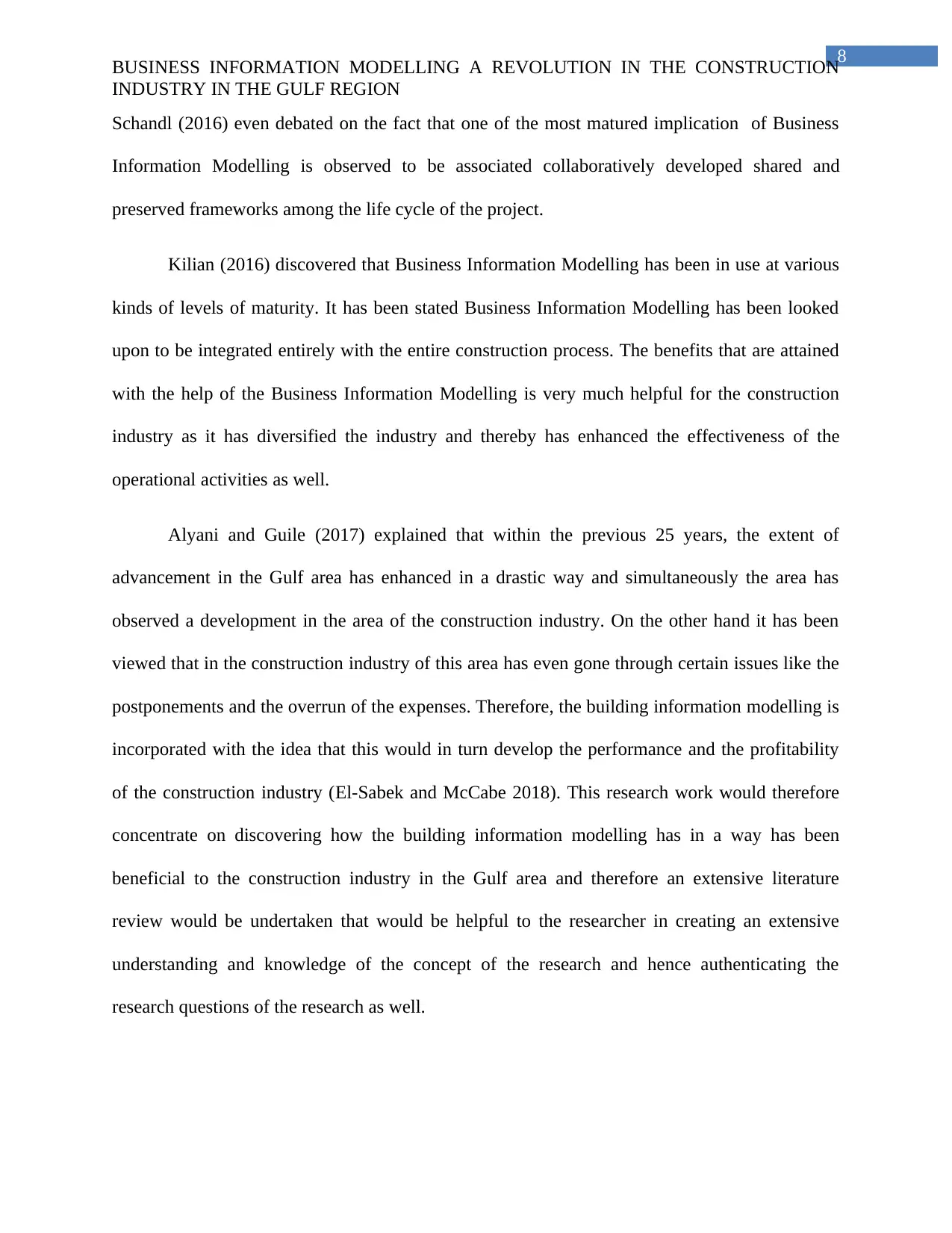
8
BUSINESS INFORMATION MODELLING A REVOLUTION IN THE CONSTRUCTION
INDUSTRY IN THE GULF REGION
Schandl (2016) even debated on the fact that one of the most matured implication of Business
Information Modelling is observed to be associated collaboratively developed shared and
preserved frameworks among the life cycle of the project.
Kilian (2016) discovered that Business Information Modelling has been in use at various
kinds of levels of maturity. It has been stated Business Information Modelling has been looked
upon to be integrated entirely with the entire construction process. The benefits that are attained
with the help of the Business Information Modelling is very much helpful for the construction
industry as it has diversified the industry and thereby has enhanced the effectiveness of the
operational activities as well.
Alyani and Guile (2017) explained that within the previous 25 years, the extent of
advancement in the Gulf area has enhanced in a drastic way and simultaneously the area has
observed a development in the area of the construction industry. On the other hand it has been
viewed that in the construction industry of this area has even gone through certain issues like the
postponements and the overrun of the expenses. Therefore, the building information modelling is
incorporated with the idea that this would in turn develop the performance and the profitability
of the construction industry (El-Sabek and McCabe 2018). This research work would therefore
concentrate on discovering how the building information modelling has in a way has been
beneficial to the construction industry in the Gulf area and therefore an extensive literature
review would be undertaken that would be helpful to the researcher in creating an extensive
understanding and knowledge of the concept of the research and hence authenticating the
research questions of the research as well.
BUSINESS INFORMATION MODELLING A REVOLUTION IN THE CONSTRUCTION
INDUSTRY IN THE GULF REGION
Schandl (2016) even debated on the fact that one of the most matured implication of Business
Information Modelling is observed to be associated collaboratively developed shared and
preserved frameworks among the life cycle of the project.
Kilian (2016) discovered that Business Information Modelling has been in use at various
kinds of levels of maturity. It has been stated Business Information Modelling has been looked
upon to be integrated entirely with the entire construction process. The benefits that are attained
with the help of the Business Information Modelling is very much helpful for the construction
industry as it has diversified the industry and thereby has enhanced the effectiveness of the
operational activities as well.
Alyani and Guile (2017) explained that within the previous 25 years, the extent of
advancement in the Gulf area has enhanced in a drastic way and simultaneously the area has
observed a development in the area of the construction industry. On the other hand it has been
viewed that in the construction industry of this area has even gone through certain issues like the
postponements and the overrun of the expenses. Therefore, the building information modelling is
incorporated with the idea that this would in turn develop the performance and the profitability
of the construction industry (El-Sabek and McCabe 2018). This research work would therefore
concentrate on discovering how the building information modelling has in a way has been
beneficial to the construction industry in the Gulf area and therefore an extensive literature
review would be undertaken that would be helpful to the researcher in creating an extensive
understanding and knowledge of the concept of the research and hence authenticating the
research questions of the research as well.
⊘ This is a preview!⊘
Do you want full access?
Subscribe today to unlock all pages.

Trusted by 1+ million students worldwide
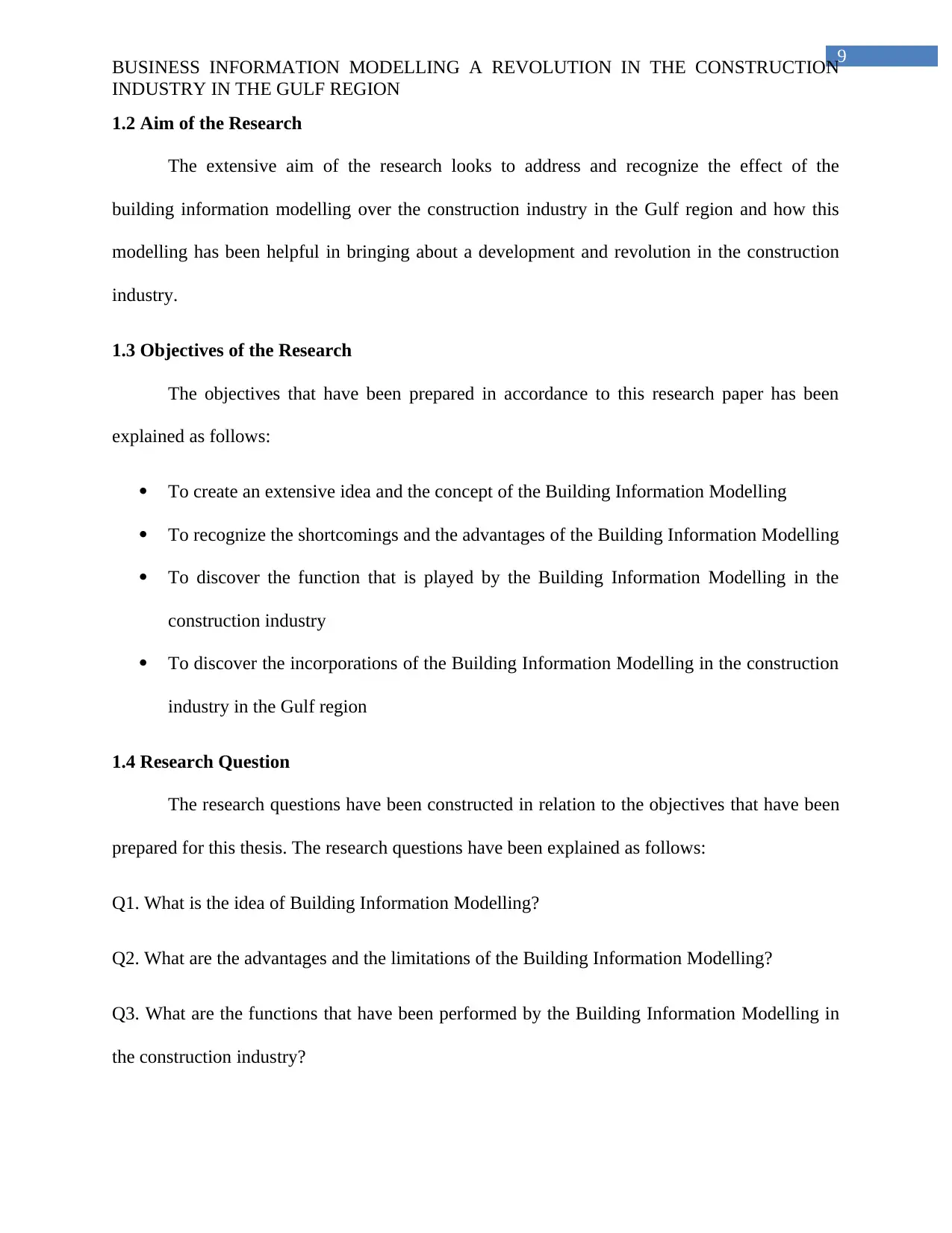
9
BUSINESS INFORMATION MODELLING A REVOLUTION IN THE CONSTRUCTION
INDUSTRY IN THE GULF REGION
1.2 Aim of the Research
The extensive aim of the research looks to address and recognize the effect of the
building information modelling over the construction industry in the Gulf region and how this
modelling has been helpful in bringing about a development and revolution in the construction
industry.
1.3 Objectives of the Research
The objectives that have been prepared in accordance to this research paper has been
explained as follows:
To create an extensive idea and the concept of the Building Information Modelling
To recognize the shortcomings and the advantages of the Building Information Modelling
To discover the function that is played by the Building Information Modelling in the
construction industry
To discover the incorporations of the Building Information Modelling in the construction
industry in the Gulf region
1.4 Research Question
The research questions have been constructed in relation to the objectives that have been
prepared for this thesis. The research questions have been explained as follows:
Q1. What is the idea of Building Information Modelling?
Q2. What are the advantages and the limitations of the Building Information Modelling?
Q3. What are the functions that have been performed by the Building Information Modelling in
the construction industry?
BUSINESS INFORMATION MODELLING A REVOLUTION IN THE CONSTRUCTION
INDUSTRY IN THE GULF REGION
1.2 Aim of the Research
The extensive aim of the research looks to address and recognize the effect of the
building information modelling over the construction industry in the Gulf region and how this
modelling has been helpful in bringing about a development and revolution in the construction
industry.
1.3 Objectives of the Research
The objectives that have been prepared in accordance to this research paper has been
explained as follows:
To create an extensive idea and the concept of the Building Information Modelling
To recognize the shortcomings and the advantages of the Building Information Modelling
To discover the function that is played by the Building Information Modelling in the
construction industry
To discover the incorporations of the Building Information Modelling in the construction
industry in the Gulf region
1.4 Research Question
The research questions have been constructed in relation to the objectives that have been
prepared for this thesis. The research questions have been explained as follows:
Q1. What is the idea of Building Information Modelling?
Q2. What are the advantages and the limitations of the Building Information Modelling?
Q3. What are the functions that have been performed by the Building Information Modelling in
the construction industry?
Paraphrase This Document
Need a fresh take? Get an instant paraphrase of this document with our AI Paraphraser
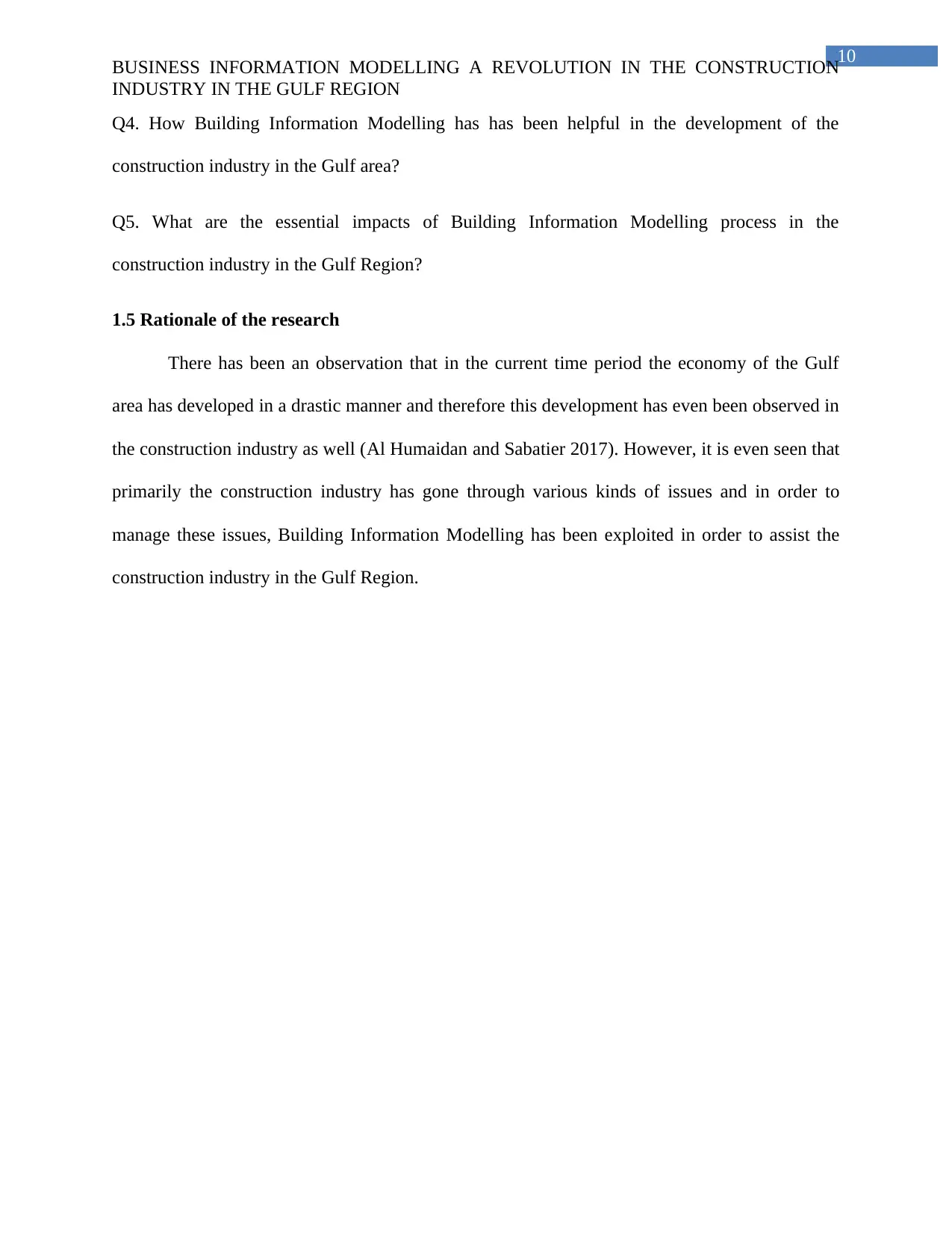
10
BUSINESS INFORMATION MODELLING A REVOLUTION IN THE CONSTRUCTION
INDUSTRY IN THE GULF REGION
Q4. How Building Information Modelling has has been helpful in the development of the
construction industry in the Gulf area?
Q5. What are the essential impacts of Building Information Modelling process in the
construction industry in the Gulf Region?
1.5 Rationale of the research
There has been an observation that in the current time period the economy of the Gulf
area has developed in a drastic manner and therefore this development has even been observed in
the construction industry as well (Al Humaidan and Sabatier 2017). However, it is even seen that
primarily the construction industry has gone through various kinds of issues and in order to
manage these issues, Building Information Modelling has been exploited in order to assist the
construction industry in the Gulf Region.
BUSINESS INFORMATION MODELLING A REVOLUTION IN THE CONSTRUCTION
INDUSTRY IN THE GULF REGION
Q4. How Building Information Modelling has has been helpful in the development of the
construction industry in the Gulf area?
Q5. What are the essential impacts of Building Information Modelling process in the
construction industry in the Gulf Region?
1.5 Rationale of the research
There has been an observation that in the current time period the economy of the Gulf
area has developed in a drastic manner and therefore this development has even been observed in
the construction industry as well (Al Humaidan and Sabatier 2017). However, it is even seen that
primarily the construction industry has gone through various kinds of issues and in order to
manage these issues, Building Information Modelling has been exploited in order to assist the
construction industry in the Gulf Region.
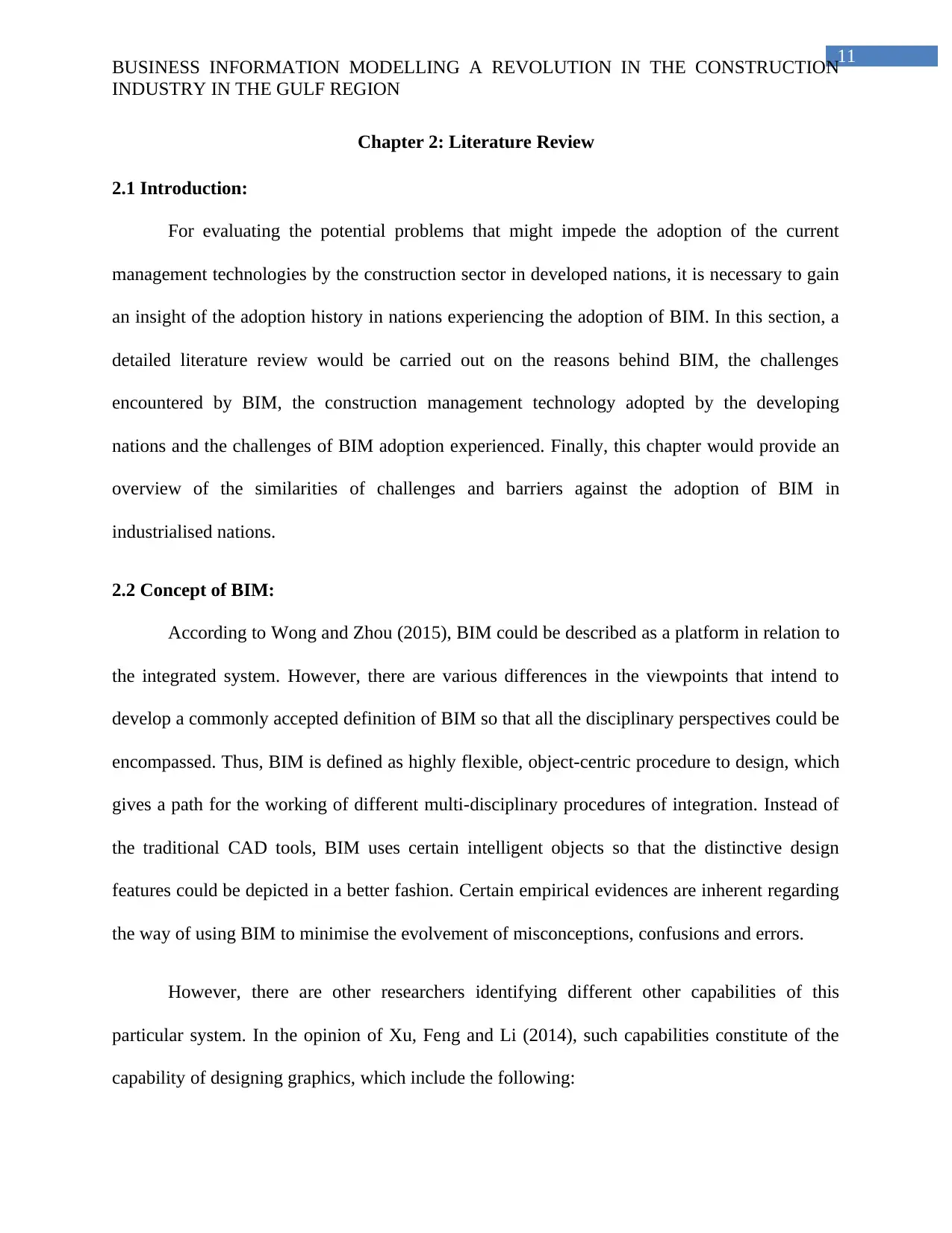
11
BUSINESS INFORMATION MODELLING A REVOLUTION IN THE CONSTRUCTION
INDUSTRY IN THE GULF REGION
Chapter 2: Literature Review
2.1 Introduction:
For evaluating the potential problems that might impede the adoption of the current
management technologies by the construction sector in developed nations, it is necessary to gain
an insight of the adoption history in nations experiencing the adoption of BIM. In this section, a
detailed literature review would be carried out on the reasons behind BIM, the challenges
encountered by BIM, the construction management technology adopted by the developing
nations and the challenges of BIM adoption experienced. Finally, this chapter would provide an
overview of the similarities of challenges and barriers against the adoption of BIM in
industrialised nations.
2.2 Concept of BIM:
According to Wong and Zhou (2015), BIM could be described as a platform in relation to
the integrated system. However, there are various differences in the viewpoints that intend to
develop a commonly accepted definition of BIM so that all the disciplinary perspectives could be
encompassed. Thus, BIM is defined as highly flexible, object-centric procedure to design, which
gives a path for the working of different multi-disciplinary procedures of integration. Instead of
the traditional CAD tools, BIM uses certain intelligent objects so that the distinctive design
features could be depicted in a better fashion. Certain empirical evidences are inherent regarding
the way of using BIM to minimise the evolvement of misconceptions, confusions and errors.
However, there are other researchers identifying different other capabilities of this
particular system. In the opinion of Xu, Feng and Li (2014), such capabilities constitute of the
capability of designing graphics, which include the following:
BUSINESS INFORMATION MODELLING A REVOLUTION IN THE CONSTRUCTION
INDUSTRY IN THE GULF REGION
Chapter 2: Literature Review
2.1 Introduction:
For evaluating the potential problems that might impede the adoption of the current
management technologies by the construction sector in developed nations, it is necessary to gain
an insight of the adoption history in nations experiencing the adoption of BIM. In this section, a
detailed literature review would be carried out on the reasons behind BIM, the challenges
encountered by BIM, the construction management technology adopted by the developing
nations and the challenges of BIM adoption experienced. Finally, this chapter would provide an
overview of the similarities of challenges and barriers against the adoption of BIM in
industrialised nations.
2.2 Concept of BIM:
According to Wong and Zhou (2015), BIM could be described as a platform in relation to
the integrated system. However, there are various differences in the viewpoints that intend to
develop a commonly accepted definition of BIM so that all the disciplinary perspectives could be
encompassed. Thus, BIM is defined as highly flexible, object-centric procedure to design, which
gives a path for the working of different multi-disciplinary procedures of integration. Instead of
the traditional CAD tools, BIM uses certain intelligent objects so that the distinctive design
features could be depicted in a better fashion. Certain empirical evidences are inherent regarding
the way of using BIM to minimise the evolvement of misconceptions, confusions and errors.
However, there are other researchers identifying different other capabilities of this
particular system. In the opinion of Xu, Feng and Li (2014), such capabilities constitute of the
capability of designing graphics, which include the following:
⊘ This is a preview!⊘
Do you want full access?
Subscribe today to unlock all pages.

Trusted by 1+ million students worldwide
1 out of 74
Related Documents
Your All-in-One AI-Powered Toolkit for Academic Success.
+13062052269
info@desklib.com
Available 24*7 on WhatsApp / Email
![[object Object]](/_next/static/media/star-bottom.7253800d.svg)
Unlock your academic potential
Copyright © 2020–2025 A2Z Services. All Rights Reserved. Developed and managed by ZUCOL.





